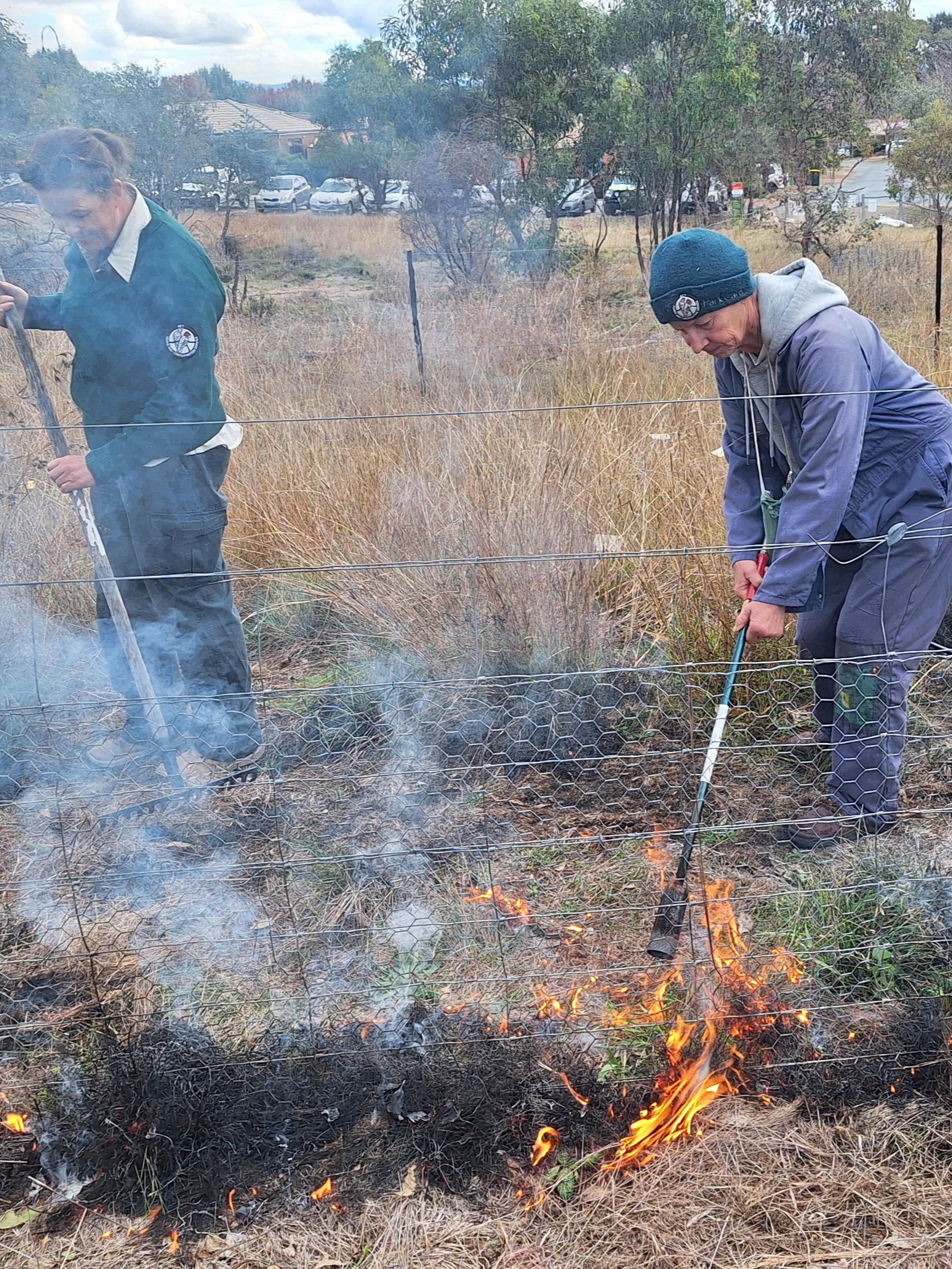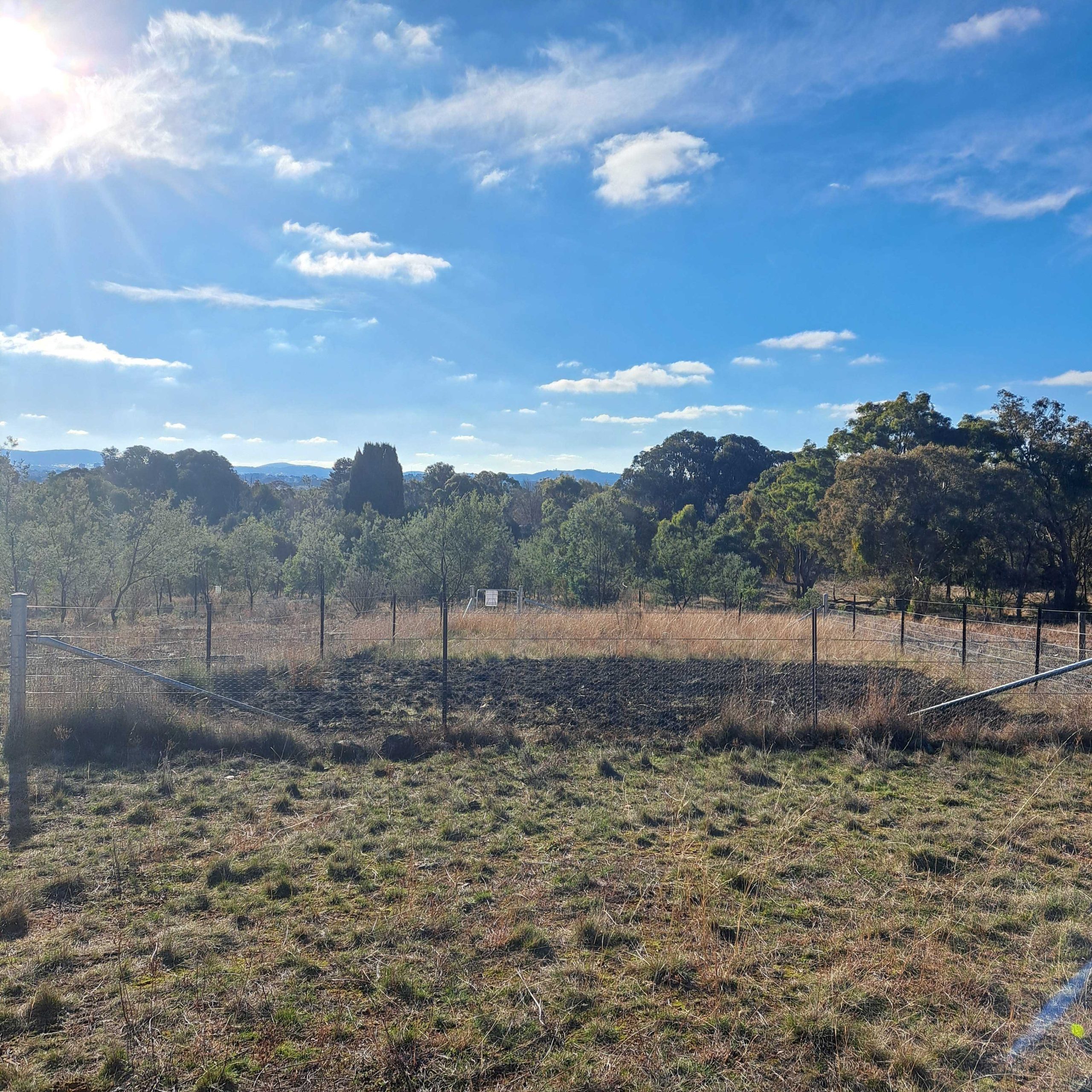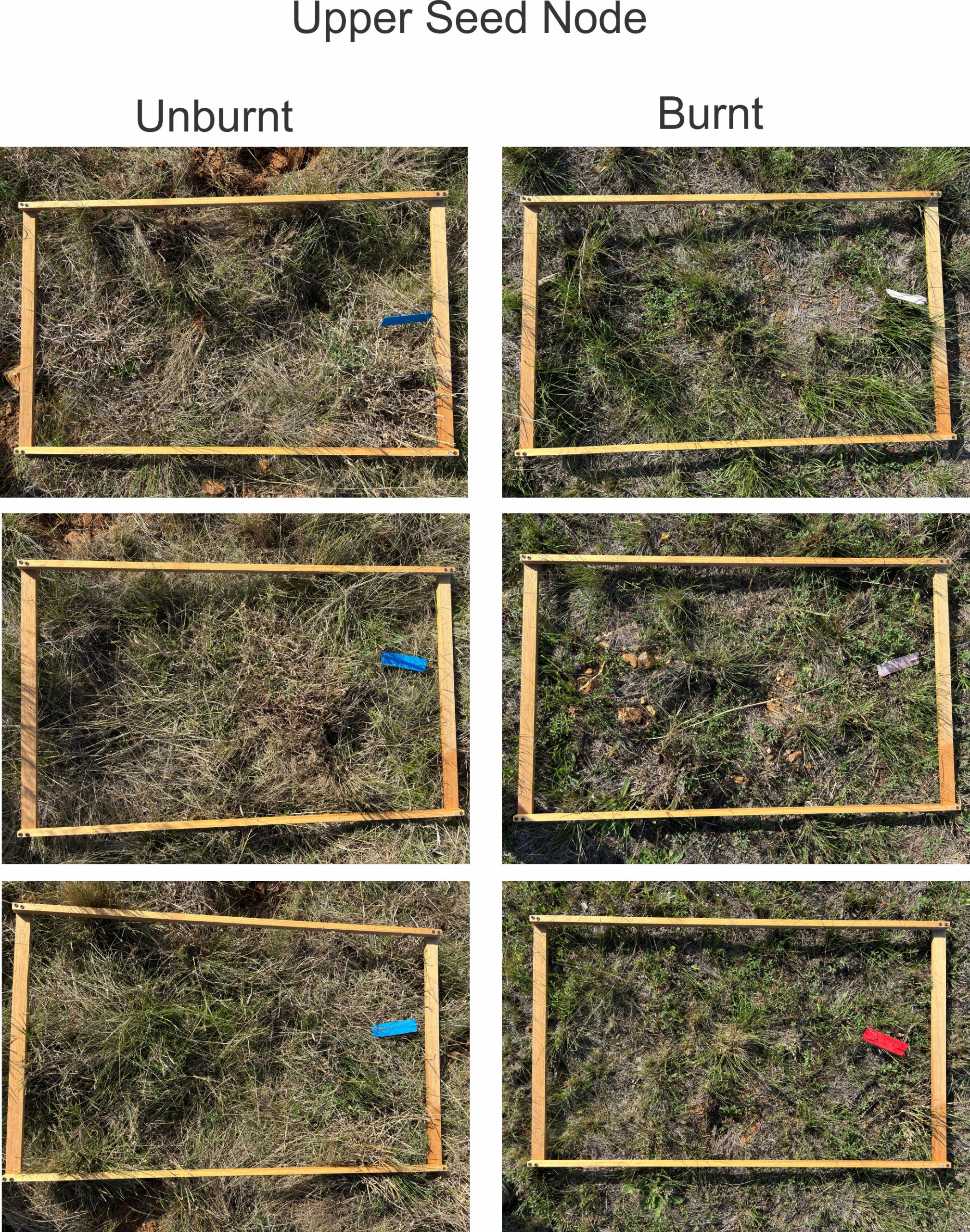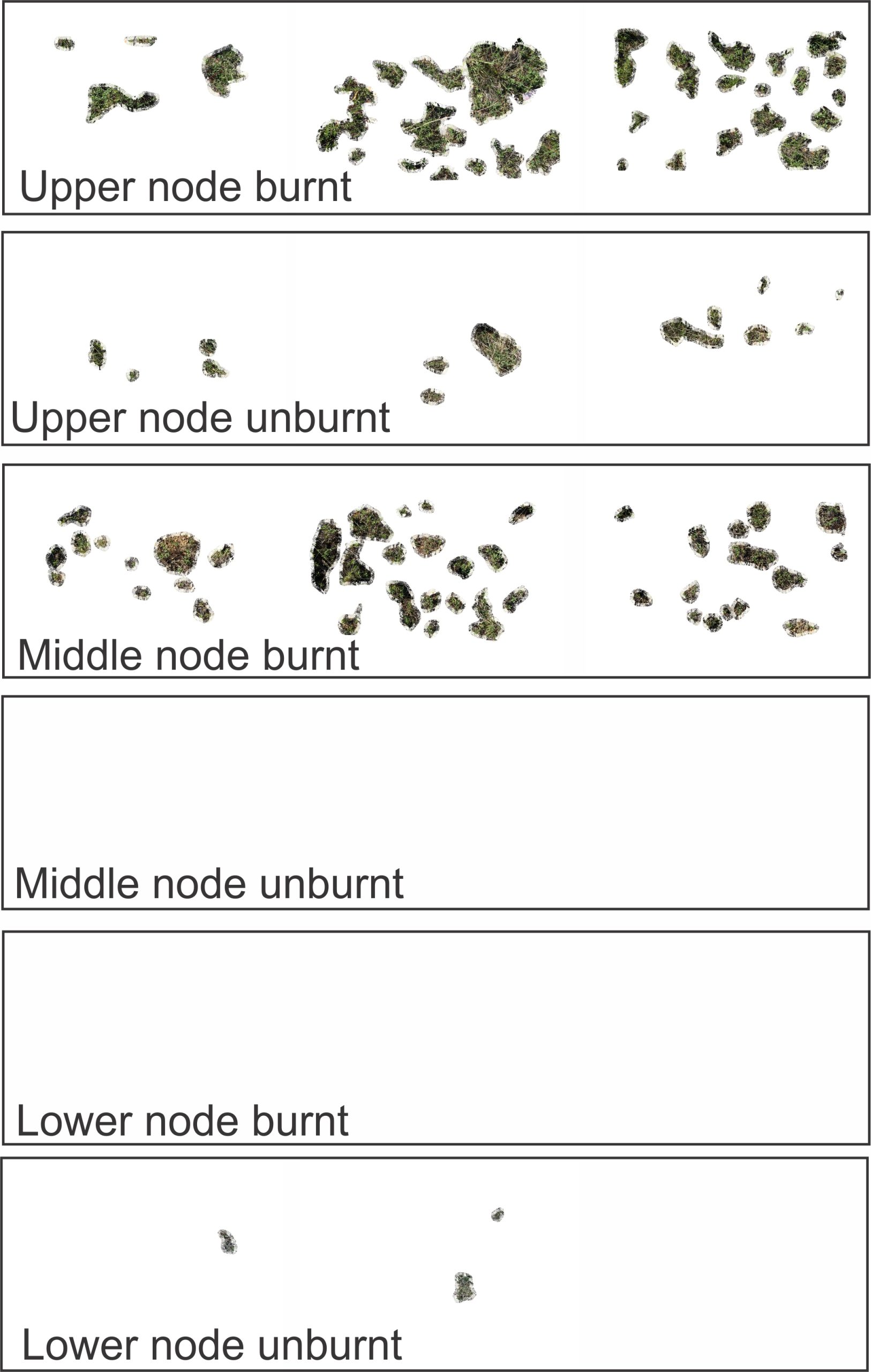
Burning the Lower Seeding Node in the nature reserve east of The Fair (photo J. Marsh)
St John’s Wort spread like wildfire across the Canberra region over the past years, wreaking havoc on native plant species in grasslands and grassy woodlands. St John’s Wort (SJW) is listed as one of the four most serious grassland weeds in the ACT Government’s Natural Temperate Grassland Endangered Ecological Community Action Plan, emphasising the gravity of the environmental threat it poses.
Known for its use in alternative therapies, the noxious weed was introduced to Australia from Europe in 1875 to be cultivated for medicinal purposes. Attempts to contain SJW to private land failed, and it rapidly reproduced becoming highly invasive.
Members of the Friends of Mount Majura (FoMM) and the Friends of Grasslands recently discussed control methods including the effect of cool burns (Minutes of the discussion).
Here we present observations of the results of burns carried out by staff of Canberra Nature Park North and the Office of Nature Conservation in winter 2024 at three small plots in the nature reserve east of The Fair, North Watson, where FoMM began work in 2012 to improve the conditions of heavily degraded grassy woodland (further information: Progress @ The Fair).
The burns were carried out to study the general effects of low intensity fire on the Fair’s grassy woodland as part of ONC’s restoration project in the area rather than to study the response of SJW to fire. However, we think the SJW response was interesting enough to report on and to share with a wider audience.
This map shows the 10ha site of The Fair project (large green polygon) with three 10m x 20m fenced enclosures or “Seeding Nodes” (small green rectangles) built in 2020 to foster local wildflowers (further information: Seeding Nodes). These fenced seeding nodes are located in different “landscape zones” (blue polygons on the map) from west to east on the lower slope with deep soil, on the middle slope surrounded by trees on three sides, and on the upper slope in a cleared area. The middle and upper slope have shallow rocky soils and larger inter tussock space with a higher diversity of native herbs compared to the lower slope.
FoMM began to treat SJW in the area of the lower slope in the 2014/15 season and over time extended the treatment to the upper slope, thus, the cleared area of the upper slope is the area with the least treatment. The methods included spraying with the selective herbicide Starane, manual removal of plants and cutting-off seed heads. FoMM carried out strictly manual removal of SJW in the seeding nodes to avoid off-target damage by spraying. SJW was not controlled in the area surrounding The Fair project site.

Seeding node of the upper slope with the southern half burnt on the 19th June 2024 (photo B. Read)
On the 19th June 2024 the southern half of each seeding node enclosure was burnt (an earlier burn of the lower seeding node in May failed because of the wet conditions). 10 weeks later, on the 29th August we took photographs of the upper seeding node, the middle seeding node and the lower seeding node; the photos show views from north to south with the strong regrowth in all burnt plots visible as bright green.
We placed a frame of 1.0m x 0.6m on three randomly chosen sites in the burnt and in the unburnt plots of each seeding node and took high-resolution photographs of the vegetation inside the frame that allowed us to distinguish SJW.
 The photographs of the burnt sites are shown on the right and those of the unburnt sites on the left for the upper seeding node, the middle seeding node, and the lower seeding node, an example is shown on the left.
The photographs of the burnt sites are shown on the right and those of the unburnt sites on the left for the upper seeding node, the middle seeding node, and the lower seeding node, an example is shown on the left.
We then processed the photographs to highlight the SJW plants that we could identify; an example of the identification and marking of SJW within the 1.0m x 0.6m frame is shown here.
 Finally, we plotted the highlighted SJW of the 3 photographs taken each in the unburnt and the burnt half of each seeding node side by side. The panel on the right shows the processed SJW images (from the top): burnt upper seeding node, unburnt upper seeding node, burnt middle seeding node, unburnt middle seeding node, burnt lower seeding node and unburnt lower seeding node.
Finally, we plotted the highlighted SJW of the 3 photographs taken each in the unburnt and the burnt half of each seeding node side by side. The panel on the right shows the processed SJW images (from the top): burnt upper seeding node, unburnt upper seeding node, burnt middle seeding node, unburnt middle seeding node, burnt lower seeding node and unburnt lower seeding node.
Observation (1) Difference of growth burnt and unburnt. Consistent at the upper and middle seeding nodes is the observation that unburnt plots have a lower regrowth rate compared to the burnt plots with the greatest difference between the unburnt plot and the burnt plot observed in the middle seeding node. We conclude that the shadowing by grass canopy suppressed SJW growth from lateral underground stems; the opening of the grass canopy by burning benefited SJW where it was present. At the time of this investigation, we did not notice SJW seedlings from germination.
Observation (2) Difference of growth between burnt plots
The difference between the burnt plot of the lower seeding node versus the burnt plots of the middle and the upper seeding nodes could be best explained with a longer and persistent treatment of SJW at the lower slope. If SJW in the lower seeding node was present in a number similar to the middle and upper seeding nodes it would have shown in a higher rate of regrowth in the burnt plot.
A more numerous lateral underground stem formation in shallow soils may have also contributed to the very large number of rosettes observed particularly in the upper seeding node.
Waltraud Pix, 7 September 2024
For the original data: convenor@majura.org


